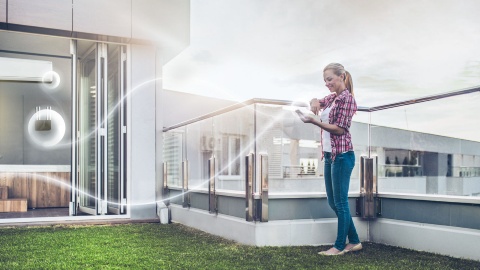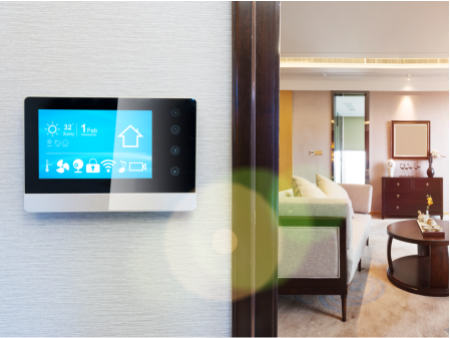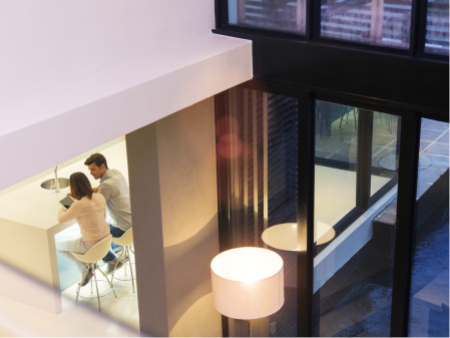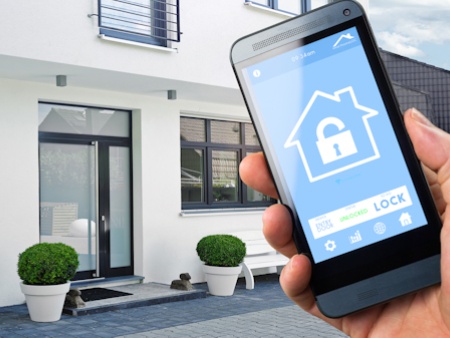
Comfortable, safe and energy-efficient
Smart homes and buildings make life more convenient
Smart home and building technology is booming and its future is projected to be even more impressive: Statista predicts that the smart home market alone will continue to expand at a 12.82% annual growth rate and reach around $47 billion by 2025.
We live in an increasingly connected world, shaped by ever more sophisticated technologies as the IoT approaches tipping point. The digitalization and networking of more and more smart devices is transforming all areas of our life, reaching beyond smart factories, wearables, cars and suchlike to also redefine the work in offices and public buildings as well as the home experience.
The demand for smart home and building devices and applications is experiencing dynamic growth as more and more consumers and companies are looking to leverage the comfort, energy efficiency, and security benefits of smart home and building technologies.
The impact of the COVID-19 pandemic
The COVID-19 pandemic has accelerated the adoption of smart home technologies. During the various stages of lockdown, many private homes morphed into offices, schools, entertainment hubs, fitness studios, and even healthcare centers. This shift in needs has also driven disruptive changes in terms of the range, functionality, and performance of smart home applications and devices now in demand. Today’s smart homes are much more than just a refrigerator that reorders milk or a coffee machine that recognizes users and knows their preferences. By 2026, ABI Research predicts that “the smart home market will reach $317 billion, up 5 percent over pre-COVID-19 forecasts.”
But the pandemic has also had an impact on public buildings and offices: access controls are being stepped up to monitor the number of people in a building, the air quality inside a building plays a major role, and there are also stricter hygiene regulations. Here, too, smart solutions such as presence detection or sensors like the XENSIV™ PAS CO2 sensor can help.
What makes homes and buildings smart?
According to projections by the United Nations, more than seven out of ten people will live in cities by the year 2050. This will push the development of megacities with high-rise buildings, large apartment blocks, and massive office/public buildings. Digitalization will play a defining role in all of these buildings. According to the European Telecommunications Network Operators’ Association, there will be around 154 million active IoT connections in smart buildings by 2025. And that’s just Europe!
Infineon’s semiconductor solutions enable smart home appliances and systems in building services to adapt to their situation and surroundings in operation. Sensors, actuators, and control systems all work together to enable components in a smart home or smart building to correctly collect, evaluate, and process real-time data before executing or initiating the appropriate action or reaction. In this context, security solutions safeguard the system and all of its activities against external cyber-attacks.
SENSE: Sensors are a smart building’s nervous system
Infineon’s XENSIV™ family offers a wide range of solutions for such situations:
XENSIV™ MEMS microphones can be used to implement voice control, for example. Capacitive sensors from the CAPSENSE™ family are an elegant and reliable solution for controlling devices via touch.
Meanwhile, motions can be effectively detected by radar sensors. With their small form factor and low power consumption, Infineon’s highly integrated XENSIV™ 60 GHz radar sensor solutions bring innovative, intuitive sensing capabilities to many applications.
Infineon’s REAL3™ image sensors with ToF technology supply ac-curate depth data in real time, react quickly, feature contactless operation, and are robust against ambient light.
COMPUTE: Microcontrollers for made-to-measure IoT control solutions
XMC1000 microcontrol-lers with an Arm® Cortex®-M0 core and cutting-edge 65 nm technology are used in connected LED power supplies, or in wireless-charging solutions. Po-tential applications in smart homes and smart buildings for XMC4000 microcon-trollers powered by Arm® Cortex®-M4 with a built-in DSP instruction set range from solar converters to sense & control and lighting networks.
With their dual-CPU architecture, PSoC™ 6 microcontrollers bridge the gap between high performance and low energy consumption and are tailored to applications in IoT devices. Finally, Infineon’s PSoC™ 4 is a true problem-solver: Functions such as analog sensor integration, capacitive touch, and wireless connectivity are all integrated as standard.
ACTUATE: Power semiconductors guarantee high efficiency in energy conversion
Actuators use the data and information received to control and actuate the connected devices in the relevant building. Infineon’s OptiMOS™ N-channel power MOSFETs are designed for high-performance applications, boasting high efficiency, high power density, and optimization for high switching frequencies. Highly integrated ICs for motor control applications like the iMOTION™ series and intelligent power modules (IPMs) from the CIPOS™ family have been developed to keep motors running efficiently in household appliances, fans, and pumps, among other things.
Power management applications for main power supplies to home appliances, set-top boxes, or even telecommunications systems/servers with a maximum rated output power of 43 W can be realized with robust CoolSET™ AC-DC power stages. Infineon’s portfolio is neatly rounded off by a wide variety of discrete IGBTs.
Here you can find more information about our technology for optimizing power generation, transmission, and consumption.
CONNECT: Networking for efficient data exchange
Infineon’s AIROC™ Bluetooth portfolio consists of purely Bluetooth Low Energy-only and dual-mode Bluetooth solutions that support Bluetooth Classic (i.e., Basic Rate (BR) and Enhanced Data Rate (EDR)), as well as Bluetooth LE. The Bluetooth SDK contains everything you need to build dual-mode applications (BR + EDR + Bluetooth LE). The Bluetooth SDK, along with the ModusToolbox™ IDE, and Bluetooth configurator tools all combine to form a powerful but easy to use toolset that will help you create amazing, Bluetooth-enabled IoT solutions.
SECURE: Scalable, easy-to-integrate security solutions
Infineon’s OPTIGA™ family offers a broad product portfolio for embedded security solutions and secured cellular connectivity designed for easy integration. These hardware-based security solutions scale from basic authentication chips to sophisticated cloud implementations. With our OPTIGA™ Authenticate family we give “things” an identity to verify authenticity. This is the prerequisite to create trust in the digital world, especially within the IoT. The OPTIGA™ Connect product family enables our customers to connect their products via secured cellular connectivity. Enabling trusted data to empower integrity and enabling trustworth communication to foster confidentiality are the clear goals of our OPTIGA™ Trust and OPTIGA™ TPM families.
Finally, SECORA™ Blockchain is a fast, easy-to-use Java Card™ solution supporting best-in-class security for blockchain system implementation. It makes the application more secure and easier to designing for the customer’s block chain system easier.
Quieter, energy-efficient appliances driven by intuitive sensor-based operation
Smart home appliances
Modern home appliances are increasingly smart and connected, providing a seamless, remote user experience.
Home appliances, also referred to as domestic appliances, electric appliances or household appliances are part of smart home automation networks. Due to rising economies and evolving consumer lifestyles, the home appliances market is expected to register a CAGR of more than 4% during the forecast period. The increase in consumer disposable income, high standard of living and the need for convenience are driving many consumers to purchase smart home appliances. These devices offer advanced features, promise greater convenience, reduce labor and can even save energy. And the market will continue to grow, driven significantly by trends such as effectiveness, variety, sustainability, stylish design and smart functionality of home appliances.
Infineon's products, solutions and tools enable smart and connected home appliances to be securely detected, controlled and connected. For example Infineon’s Discrete IGBTs products designed for induction heating applications, in combination with PSoC microcontrollers for system control, AIROC™ Wi-Fi & Combos products, and XENSIV™ sensors enable highly compact, robust, and reliable systems that consume less power and offer a rich user interface.
The CIPOS™ family is the optimal solution for highly integrated compressor drives whilst discrete solutions are the best choice, whenever the layout flexibility and thermal performance optimization are the major factors. They can all be combined with Infineon’s iMOTION™ products for dedicated motor control. For the auxiliary power supply, the CoolSET™ rounds up the power portfolio by offering increased robustness and performance.
Podcast4Engineers: Home appliance trends with Jens Reinstaedt

Smartification and electrification aren’t just limited to our smartphones and computers anymore; these trends are steadily making their way into our home appliances and the market is booming. But what technologies are driving home appliance innovation and how do semiconductors play a role?
Listen to our latest podcasts to learn more about home appliances and how Infineon technology is powering the smart home of tomorrow.
The rise of the smart kitchen
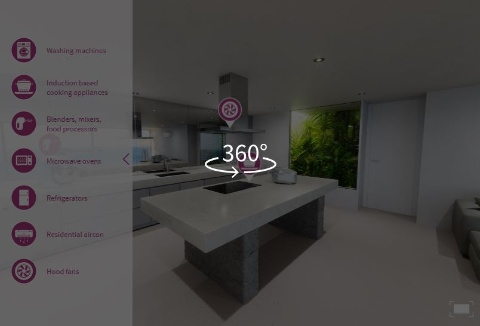
Kitchens are becoming smarter. They connect to your world and they interact with you. Appliances are now expected to be energy-efficient, connected, intuitive, and secure. Experience our interactive home and find all information for your design requirements.
System solutions for the smart home application era

Users control operation and receive live data from appliances, whether it's the contents of the refrigerator or information on the status of laundry. In turn, manufacturers can remotely analyze the device and suggest predictive maintenance to avoid costly repairs. This webinar will show you how Infineon's smartest power designs can help you achieve the highest efficiencies, smallest form factors and significantly improve your appliances' carbon footprint to make them smart, connected, and secured.
Whitepaper: The rise of the smart kitchen - Connected living in the heart of the home

The smart kitchen is here to stay, with IoT-enabled appliances such as fridge-freezers, ovens, washing machines and dishwashers becoming part of intelligent home automation networks. This whitepaper charts the rapid rise of the smart kitchen and looks at how advances in electronic solutions have resulted in a new generation of quieter and more energy-efficient appliances driven by intuitive sensor-based operation. This trend has delivered higher levels of functionality, making life more convenient for tech-savvy consumers.
Login to MyInfineon and read our new whitepaper.
Smartify your aircon with Infineon’s solution portfolio
Heating ventilation and air conditioning (HVAC)
Air conditioning systems are joining the ever-expanding list of “things” that are connecting to the Internet of Things. This is reflecting – and also driving – shifts in consumer expectations around aircon systems.
Standard/basic functionality such as stable and smooth start-up plus variable operating speeds and vibration suppression are considered essential must-haves. In addition, cooling systems in private homes must be quiet. Today’s heating ventilation and air conditioning (HVAC) systems should also be equipped with power devices that make them more energy efficient. In keeping with the smart trend among household appliances, home owners additionally expect smart air conditioners to offer various intelligent features that make life more convenient. And as more and more air conditioning units are connecting to the cloud, secure communication and interoperability within the home automation network are growing in importance.
Infineon’s offering Infineon offering the commercial HVAC application
Infineon provides its customers with the right technologies and innovations to address current and future security, functionality, connectivity and performance demands for smart heating ventilation and air conditioning systems. Examples:
The XENSIV™ family provides manufacturers with best- in-class MEMS sensors to enable e.g. smart aircon systems to “see”, “hear”, “feel” and “understand” their environment and incorporate more intelligence into their designs. CIPOS™ IPMs integrate the latest power semiconductors and control IC technology to create highly integrated, compact power modules to drive motors across a wide range of applications. PSoC™ 6 Microcontrollers provide a secure solution for IoT developments, supporting multiple, simultaneous environments without the need for external memories or SoCs. Infineon possesses a team of strong technical experts and partners to provide its customers with the tools and sup- port they need to design and implement future-proof smart aircon systems.
Podcast4Engineers: Commercial HVAC Trends with Lara Berghoff

Whether making factories more efficient or your office complex more comfortable, commercial HVAC systems are enabling smarter buildings. In this episode, our application manager Lara discusses some of the market drivers and opportunities in the world of C-HVAC.
Training: Introduction to sensor-enabled predictive maintenance for HVAC systems
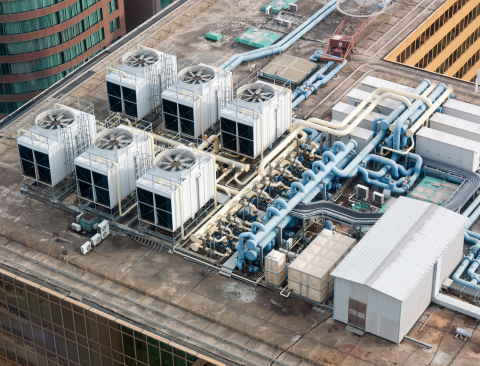
The training gives an overview of predictive maintenance in HVAC and the role of sensors. It presents our offering and partner approach.
Residential heating, ventilation, and air conditioning systems

Smart, smaller, more powerful and energy-efficient: Today’s room air conditioning units must fulfill a growing list of demands. Because they are used in private homes, quiet aircon systems are highly sought after. Functions such as stable and smooth starting, a wide range of operating speeds and vibration suppression round out the list of must-haves.
Demonstrator Predictive maintenance in HVAC
Make connected buildings smart with Infineon’s full-spectrum sensor portfolio
Contextual awareness – the senses of the IoT
Sensors make homes and buildings smart by enabling them to “see”, “feel” and “hear” their environment – just like our human five senses do.
A smart building or home becomes smart through its connected and intelligent devices that are placed inside of it, for example heating, ventilation and air conditioning, elevators, access control, lighting, energy supply, or water heating systems. These elements itself are not smart. However, when equipped with the right technology, they are able to “see”, “hear” and “understand” their surroundings and perform appropriate actions. Sensors are the neural system of a building that collect in real-time data about a building’s operation, environment and its devices.
How radar can make your home intuitively smart
Reflecting our holistic approach to IoT design, our vision is to complement our XENSIV™ sensors with state-of-the-art software to create a comprehensive picture of the world around us. Our broad sensor portfolio spans MEMS microphones, plus pressure, radar, environmental, and 3D image sensors (REAL3™). All of which enable designers to create more intelligent, contextually aware devices.
Radar-based entrance counter: Accurate, anonymous, contactless (1/2)

COVID-19 has rapidly increased the need for social distancing solutions in public buildings. The smart entrance counter is one such solution. It counts when a person enters or leaves a building or a room, and simultaneously ensures social distancing. The system uses a 60-GHz radar sensor and integrated software; people are counted accurately and anonymously. A traffic-light system tells people whether access is permitted or not. The expected demand for this type of solution amounts to 90 million units globally. The system is easy to install and is simply mounted to the wall or ceiling of an entrance/exit area. It can be used in any type of building, including public buildings, retail stores and grocery stores, restaurants, schools, and corporate spaces, such as canteens, offices, etc.
Click on the next slide and watch our video.
For more information about our entrance counter solution, click here.
Radar-based entrance counter: Accurate, anonymous, contactless (2/2)
A breath of fresh air: XENSIV™ PAS CO2 sensor to detect carbon dioxide (1/2)
Although everyone has an intuitive sense of when a meeting gets "stuffy", unfortunately we humans don't have anything like sensors for ambient air quality. But Infineon does!
Indoor spaces with increased CO2 concentration levels not only have poor air quality which can for example cause headaches, here we also find raised levels of aerosol concentration – one of the most common transmission paths for COVID-19. Regular ventilation is a good preventive step, but who wants to spend lots of time sitting in a draft of cold air? Wouldn't it be great if we could only air out meeting rooms whenever it's really necessary!
Click on the next slide to watch the video to learn more about the PAS principle and how our XENSIV™ PAS CO2 sensor works.
A breath of fresh air: XENSIV™ PAS CO2 sensor to detect carbon dioxide (2/2)
Explore use cases and start evaluating!

Visit our new Makes Sense page and let Chipman show you the latest use cases and application examples!
Measure what matters
Predictive maintenance and condition monitoring
Highly reliable solutions unleashing the benefits of condition-based monitoring vs predictive maintenance with Infineon’s XENSIV™ sensor portfolio
Time and again, malfunctions in heating, ventilation, air-conditioning and refrigeration technology systems interrupt working processes and increase maintenance costs. Predictive maintenance, which is a data-based maintenance strategy for predicting system malfunctions, can be an effective solution to this. To illustrate the benefits of using a sensor-based solution, Infineon has collaborated with Klika Tech and AWS to develop a sensor-based evaluation kit. It enables the straightforward evaluation of condition monitoring and predictive maintenance. Using a range of sensors, paired with microcontrollers, embedded security, and software, it is possible to monitor various parameters of vital components such as compressors, motors, and fans in real time, so that any potential anomalies can be detected immediately. If this is the case, the respective maintenance technicians can be informed in good time – before a malfunction – to address the problem, e.g. by replacing a wearing part or cleaning an air filter.
Infineon’s broad range of XENSIV™ sensors can be deployed to monitor everything from single components of production machinery to an entire smart building ecosystem. Typical use cases include HVAC equipment where XENSIV sensors monitor current, vibration, and airflow in motors, compressors, and fans. These sensors can be combined with FreeRTOS-certified XMC™ microcontrollers and OPTIGA™ security solutions so the data collected can be processed and analyzed to enable advanced IoT features such as predictive maintenance. Thanks to our Semper™ NOR Flash Memory Family all collected data can be reliably and safely stored.
Buildings that can “hear” and “see” their environment and react accordingly: Science fiction or reality?

Listen to this exciting episode of our #MakeIoTwork podcast. Together with Julia Fichte and Manuel Hollfelder we will talk about the relevance and benefits of smart homes and buildings for tenants, residents, workers and of course the operators.
- Which technologies make buildings smart?
- How can predictive maintenance help to reduce breakdowns and costs, while extending lifetime by 20%?
- Why is it so important to work in conjunction with all the stakeholders in the ecosystem?
XENSIV Predictive Maintenance Kit
住宅とビルのオートメーションシステム
IoTが建物をより安全で快適に
スマートホームやスマートビルディングの技術的な機能が、建物の快適性、エネルギー効率、セキュリティを高めます。半導体ソリューションを用いて、建築設備に組み込まれた住宅家電やシステムを状況や環境に応じて調整することができます。センサー、アクチュエータ、制御システムの連動により、スマートホームやスマートビルディングの各コンポーネントがリアルタイムで正確なデータの収集、評価、処理を行い、これに基づき適切に作動します。その際にはセキュリティソリューションが、システムとすべての動作を攻撃から守ります。
2019年時点で、ヨーロッパのスマートビルディングにはすでに約1600万件のIoT接続が確立されています。欧州電気通信ネットワーク事業者協会(ETNO)によると、2025年には、これが約1億5400万件に増える見通しです。
インフィニオンの半導体ソリューションが住宅と商業ビルのスマート化を実現し、快適性と利便性を高めます。
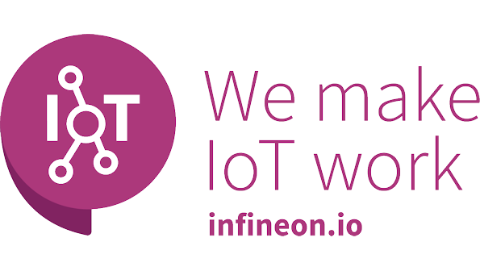
ソリューション
すぐ使える住宅やビルオートメーションシステム
インフィニオンの幅広い製品ラインナップには、スマートホームとスマートビルディング用の画期的なソリューションを実現する、カスタムされた半導体ソリューションが含まれます。メーカーによるIoTソリューションの開発と住宅やビル用のオートメーションシステムへの統合を、いちから支援します。取りわけ、この業界に新規参入するメーカーには、通常の基本的ソリューションに加えて、 XENSIV™ 予知保全評価キット が役立ちます。
センス
センサーはスマートビルディングの神経系
ビルにセンサーを設置すれば、稼働状況と周囲の環境に関するデータを集め、その情報にリアルタイムで反応できます。インフィニオンのXENSIV™ ファミリーは、次のような状況に対応した幅広いソリューションを提供しています。
たとえばXENSIV™ MEMSマイクを使って音声制御を行えます。CAPSENSE™ ファミリーの容量性センサーは、タッチセンシングでデバイスを制御する洗練され、信頼性の高いソリューションです。
他方で、レーダーセンサーで効果的に動作を検知することも可能です。インフィニオンの高度に集積されたXENSIV™ 60 GHz レーダーセンサーソリューションは、スモールフォームファクタと低消費電力により、多くのアプリケーションに画期的で直感的なセンシング機能を実現します。
ToF技術を用いたREAL3™ イメージセンサーは、 リアルタイムで正確に深度データを提供し、短時間で反応します。また、非接触で稼働させることが可能なうえ、環境光に対しても堅牢性を発揮します。
コンピュート
カスタムされた IoT 制御ソリューションに最適なマイクロコントローラ
マイクロコントローラは、あらゆる種類のビルディングコンポーネントのデータを処理します。インフィニオンのラインアップには、以下のアーキテクチャに基づく、このタイプのソリューションが数多く含まれます。
Arm® Cortex®-M0 コアと最先端の65nmテクノロジーを組み込んだXMC1000マイクロコントローラは、コネクテッドLEDへの電力供給やワイヤレス充電ソリューションに使用されます。Arm® Cortex®-M4 と DSP命令セットを搭載したXMC4000マイクロコントローラの、スマートホームやスマートビルディングへのアプリケーションの例として、ソーラーコンバータ、感知、制御および照明ネットワークなどが考えられます。
デュアルCPUアーキテクチャを採用した PSoCTM 6マイクロコントローラは、高性能と低消費電力を両立させ、IoTデバイスへのアプリケーションに特化されています。インフィニオンのPSoCTM 4 は課題を見事に解決するアナログセンサー統合、容量性タッチ、ワイヤレスコネクティビティなどの機能が、標準装備されています。
インフィニオン 32ビットArm® Cortex®-M内蔵XMC™マイクロコントローラ
アクチュエイト
パワー半導体が高いエネルギー変換効率を保証
アクチュエータは、受け取ったデータや情報を使って、ビル内の接続されたデバイスを制御し、作動させます。インフィニオンの OptiMOS™ NチャネルパワーMOSFETは、高性能のアプリケーション用に設計されており、高い効率性と電力密度を実現するだけでなく、高いスイッチング周波数にも最適です。iMOTION™シリーズのようなモータ制御用の高度に集積化されたICや、インテリジェントパワーモジュールのCIPOS™ ファミリーは、家電製品やファン、ポンプなどのモータを効率的に作動させ続けるために開発されました。
堅牢性に優れた CoolSET™ AC-DC 統合パワー段を使って、家電、セットトップボックス、通信システム/サーバなどの最大出力43Wの汎用電源に対する、電力管理アプリケーションを実現できます。インフィニオンのラインアップの最後を締めくくるのは、幅広いディスクリートIGBTです。
コネクト
効率的なデータ交換のためのネットワーキング
コネクティビティは、スマートビルディングに欠かせない機能です。コネクティビティによって、ビルの様々な要素がデータの送受信を行えるスマートなコネクテッドデバイスに変わります。そのため、インフィニオンは、あらゆる種類のコミュニケーションシステムに対応したソリューションを提供しています。
WICED Wi-Fi + Bluetoothコンボは、IoTの設計に使用できるスモールフォームファクタ用のソリューションで、IEEE 802.11a/b/g/n/ac WLAN と Bluetoothをシングルチップに搭載しています。Wi-Fi + Bluetoothコンボの多くは、 WICED Wi-Fi および ModusToolboxTM ソフトウェア開発キットでサポートされています。この開発キットが、コードの例、ツール、開発サポートなどを提供しています。
インフィニオンの Bluetoothラインアップは、 Bluetooth Low Energyのみのソリューションと、Bluetooth Classic (BRおよびEDR)とBluetooth LEの両方に対応したデュアルモードソリューションから構成されます。Bluetooth SDKは、デュアルモードアプリケーション(BR + EDR + Bluetooth LE)の構築に必要なすべての機能を備えています。Bluetooth SDKと ModusToolboxTM IDEおよびBluetooth コンフィギュレータツールを組み合わせることで、強力で使いやすいツールセットが実現し、Bluetoothを搭載した優れたIoTソリューションを開発できます。
セキュア
拡張性ある統合しやすいセキュリティソリューション
ハードウェアに組み込まれた IoTセキュリティアーキテクチャは、スマートビルディングをサイバー攻撃から守る上で欠かせません。インフィニオンは、ハードウェアをベースとした十分に実証した幅広いソリューションでこの課題に対処し、スマートホームとスマートビルディングのデータとデバイスを強力に保護することを目指しています。
OPTIGA™ ファミリーは、組み込みセキュリティソリューションと簡単に統合できるセキュアなセルラーコネクティビティを幅広いラインアップで提供します。このハードウェアベースのセキュリティソリューションは、基本的な認証チップから高度な実装まで拡張することができます。OPTIGA™ Authenticate ファミリーは、真正性を確認するため「モノ」に識別情報を与えます。これがデジタル世界、特にIoTの世界では信頼性を生み出す前提条件です。OPTIGA™ Connect ファミリーを使えばセキュアなセルラーコネクティビティを通して製品と接続することができます。信頼性の高いデータを用いて完全性を高め、確実なコミュニケーションで秘密保持を促すことが、OPTIGA™ Trustおよび OPTIGA™ TPM ファミリーの明確な目標です。
最後に SECORA™ Blockchain は、ブロックチェーンシステムの実装に向けたクラス最高のセキュリティを搭載した、短時間で簡単に使えるJava Card™ソリューションです。アプリケーションの安全性を高め、お客様のブロックチェーンシステムをより設計しやすくします。
アプリケーションの例
Home Appliances
レーダーベースのエントランスカウンター
正確で匿名かつ非接触
新型コロナウイルスの感染拡大によって、公共施設のソーシャルディスタンスを確保するソリューションを早急に確立する必要が生じています。
そんなソリューションのひとつである、スマートエントランスカウンターは、建物や部屋に出入りする人数をカウントすると同時にソーシャルディスタンスも確保します。60GHzレーダーセンサーと統合ソフトウェアを使用して、正確に匿名で人数をカウントします。
トラフィックライトシステムが、入場が許可されているかどうかを通知します。このようなソリューションの需要は、世界で9000万ユニットにのぼると予想されます。このシステムは、入口や出口の壁または天井に簡単に設置できます。公共施設、小売店、食料品店、レストラン、学校、企業スペース(社員食堂やオフィス)など、あらゆる種類の建物に実装することが可能です。
換気および警告システム
屋内で新鮮な空気を確保するPASセンサー
スマート換気および警告システムは、屋内の空気質の悪化を警告し、必要とされる新鮮な空気を供給します。光音響分光法(PAS)を使用したセンサーが、屋内の空気中のCO2含有量を極めて正確に測定します。このセンサーは、特に低周波数用に設計された高感度の音響検出器を使用しています。PAS原理により、従来のCO2センサーと比較して最大75%の省スペース化を実現しています。ppm値を直接測定できること、および革新的な設計により、迅速で簡単な搭載が可能となり、大量生産されるアプリケーションに最適となっています。
予知保全
想定外の稼働停止時間を防ぐ
暖房、換気、空調、冷蔵システムの故障は、たびたび作業工程を中断し、保守コストを増大させています。データに基づきシステムの不具合を予測する予知保全は、これに対応する効果的なソリューションになるかもしれません。センサーを使ったソリューションの有用性を示すため、インフィニオンはKlika Tech社および AWS社と連携して、センサーを搭載した評価キットを開発しました。このキットを使って、状態監視と予知保全を簡単に評価することができます。幅広いセンサーとマイクロコントーラ、組み込みセキュリティ、ソフトウェアを組み合わせることで、コンプレッサ、モータ、ファンなどの重要な部品の各種パラメータをリアルタイムで監視して、潜在的な異常を即座に検出することができます。これにより、保全を担当する技師は、不具合が起きる前の適切な時に通知を受けて、摩耗部品の交換やエアフィルターの掃除などにより問題に対処できます。
Connected Home over IP標準
異なるサプライヤーのデバイスを簡単に使用できる
世界をリードするスマートホームデバイスメーカーとサプライヤーが協力して、スマートホームの実現に向けたグローバルスタンダードを開発しています。Zigbee Allianceのワーキンググループ「Connected Home over IP」(略してCHIP)は、スマートホーム製品の互換性とセキュリティを高め、簡単に使用できるようにすることを目指しています。スマートホームソリューションの安全で簡単なデバイス設定やコントロールといった観点が、消費者の購買決定の重要な基準になりつつあります。
CHIPを使えば、設計段階から製品寿命の終わりまで、ハードウェアセキュリティチップにデバイス識別情報を保存し、更新することができます。セキュリティが安全でないパスワードの使用を排除し、保護されたファームウェア更新によりデバイスの完全性を維持し、最先端のデータ暗号アルゴリズムでプライベートデータを保護することが可能です。CHIP標準は、使いやすいハードウェアベースのセキュリティを提供することで、スマートホームデバイスメーカーがコストと余計な労力を最小限に削減し、製品のセキュリティレベルの大幅向上を図ることができるよう支援するものです。
Connected Home over IP標準とのシームレスで安全な相互運用性

- ユーザーがコーヒーメーカーのようなConnected Home over IP標準のデバイスを購入します。このデバイスには、関連するソフトウェアがあらかじめインストールされており、独自の識別情報と認証ステータスを証明する一連の認証情報が用意されています。
- このデバイスをスマートホーム内で使用できるようにするには、スマートフォンでQRコードをスキャンし、デバイスのペアリングボタンを押します。
- スマートフォンはデバイスの初期認証を確認し、ネットワーク上にセットアップします。これで準備完了です。スマートフォンやスマートスピーカーなどのデバイスから追加した製品が操作できるようになります。
パワーオーバーイーサネット
IoTの速やかな設置が可能に
パワーオーバーイーサネット(PoE)では、LANケーブルがデータの転送だけでなく、同時にデバイスへの給電も行います。そのため、建物内のセンサーや他のIoTデバイスを、従来よりはるかに短時間で設置できます。PoEは長年にわたって使用されてきましたが、最新の標準IEE802.3btでは、ツイストペア イーサネット ケーブルを介して供給できる最大電力が増えています。そのため現在は、最大100Wを提供できるようになりました。従来型のイーサネットケーブルでデバイスをスイッチにつなぐだけで、PoEスイッチは複数のデバイスに同時に給電できます。これにより、スマートビルディングシステムの設置プロセスだけでなく、その後の再構成も簡単になります。アムステルダムにある画期的なオフィスビルであるThe Edgeは、650個のPoEスイッチを設置して、PoEのメリットを活用しています。そのためユーザーは、たとえばスマートフォンのアプリ経由で照明や温度を調節できます。施設管理者は建物内のさまざまな機能すべての状況を明確に把握して、運用効率を高めることができます。20カ月の間に、従業員1人当たりコストを1,800ユーロ以上削減することができました。
